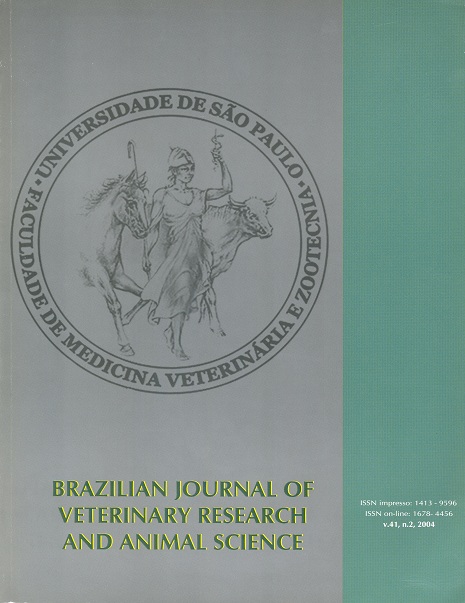Pheochromocytoma in a dog - short communication
DOI:
https://doi.org/10.1590/S1413-95962004000200006Keywords:
Adrenal Tumor, Pheochromocitoma, Dog, Diagnosis, TreatmentAbstract
Pheochromocytomas are uncommum tumors arising from the medular adrenal gland, which diagnosis is generally made at the necropsy. These tumors promote cardiac arrhythmias (increase), systemic hypertension and other clinical alterations that are attributed to the increase of the amount of catecholamines released by the tumor cells. This is a case of a fifteen years old female mongrel dog, brought to the Veterinary Hospital at UniABC, whose main complaint was intense itch, sleeplessness and considerable weight loss (12 kg in less than 3 months). The clinical examination showed bilateral mydriasis and deep cutaneous ulcer with muscle exposition, bilaterally in the toracic wall. Abdominal ultrasonography presented two oval solid formations, well-circunscribed, located next to the great vessels and at the cranial edge to left kidney, heterogeneous hipoecogenic aspect, with circumscribed inner anecogenic areas compatible with neoplasic formation in the left adrenal gland with metastases in the regional lumph node. The eletrocardiogram presented alternating wave "t" compatible with increase of cathecolamines. Two global masses of 2 and 4 cm diameter were removed, which was located cranialy to the left kidney, on the great vessels. Grossly, there were small circumscribed brown regions. The average arterial pressure during the surgery was of 150 mmHg and it fell down to 60mmHg during laparorraphy. During the first week after the surgery the dog started to sleep, was more calm and the itch almost disapeared. The diagnosis of pheochromocytoma was established with complementary examinations and concluded after the surgical removal and histopathologic examination.Downloads
Download data is not yet available.
Downloads
Published
2004-04-01
Issue
Section
UNDEFINIED
License
The journal content is authorized under the Creative Commons BY-NC-SA license (summary of the license: https://
How to Cite
1.
Carvalho CF, Vianna RS, Cruz JB da, Maiorino FC, Andrade Neto JP de, Mazzei CRN, et al. Pheochromocytoma in a dog - short communication. Braz. J. Vet. Res. Anim. Sci. [Internet]. 2004 Apr. 1 [cited 2024 Apr. 19];41(2):113-6. Available from: https://revistas.usp.br/bjvras/article/view/6265





